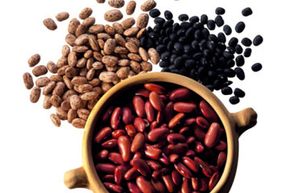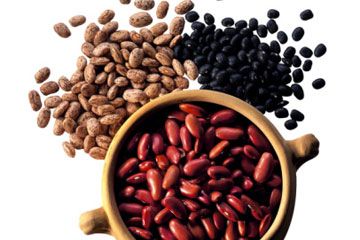Legumes are a vegetable family of bite-sized seeds. They're grown all over the world and are eaten by virtually all cultures. Legumes are one of the most all-around nutritious foods. The family includes black beans, black-eyed peas, pinto beans, white beans, garbanzo beans (chickpeas), edamame (green soybeans), fava beans, red lentils, green lentils, lima beans and kidney beans.
The Meatless Marvel
Advertisement
Legumes are packed with soluble fiber, which is broken down and absorbed by the body slowly, making you feel full for longer. Legumes contain about 12 to 15 grams of dietary fiber per cup. That's about half of what an adult needs each day. Fiber stabilizes blood sugar and also helps reduce cholesterol. Soluble fiber "flushes out" the bad cholesterol, which is perhaps the greatest health benefit of legumes. It also absorbs liquid inside the colon, which softens the stool, reducing constipation. It's also been reported that high bean consumption may reduce the risk of colon cancer [source: Johns Hopkins].
Meat, cheese, eggs and dairy products contain protein, which humans need to survive, but they also have fat and cholesterol. Legumes are essentially fat-free and cholesterol-free.
They're the most potent source of non-animal based protein. The average cup of cooked beans contains as much protein as it does fiber -- 16 grams of protein, about a third of an adult's daily needs.
The U.S. Department of Agriculture's nutritional guidelines suggest that Americans eat a minimum of three cups of legumes each week. The average American currently eats about a third of that.
Preparation and Consumption
Legumes are sold two ways: dried (in boxes, bags or bulk) or canned. Canned legumes are ready-to-eat and simply need to be warmed up in a pot or a microwave. Dried ones need to be rehydrated to ensure even cooking. There are two ways to rehydrate your beans:
- Soak dried beans overnight in cold water in the refrigerator.
- Or, add beans to boiling water, cover and let sit for three hours.
(Note that lentils and black-eyed peas don't require soaking.)
Once they're rehydrated, they're ready to be cooked. Rinse them, cover with water in a stockpot, bring the water to a boil, then reduce heat and simmer for 45 minutes. Check them to be sure they're cooking consistently and add water when necessary.
Beans are an incredibly versatile food. Cook them with salt and pepper and serve them as a hearty side dish, or use them in chili, soups, salads and casseroles (like red beans and red rice). Black beans can be mixed with salsa and chicken in a tortilla for a low-fat dinner.
The Musical Fruit
One problem with legumes: They're notorious for causing gas. They do this because some of the carbohydrates in beans are oligosaccharides, molecules that the body doesn't have the enzymes to break down. Those molecules wind up in the large intestine, where native bacteria eat them, a process that lets out gas. If you'd prefer to avoid this unpleasant side effect, eat canned legumes instead of fresh beans. The legume canning process destroys some of the oligosaccharides. Or change the water every so often while you soak your fresh beans.
Advertisement


